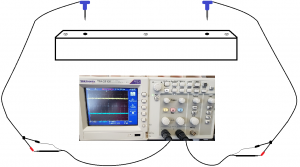Objective
A seismic refraction survey requires the initiation of a seismic wave and the recording of the propagated seismic energy at some distance away from the source. In the simplest case of a homogeneous, elastic ground, three separate types of waves can be generated and recorded. These are the compressional or P wave, the transverse shear or S wave, and the surface or Rayleigh wave, often referred to as ground roll. When the underground structure is layered and the wave speed is greater in the deeper layer than in the top layer, additional arrivals may be seen on the seismograms. Of the three waves, the most important for interpretation of the structure is the refracted P wave. The P wave has the fastest speed of all the three waves and is always the first to arrive at a seismic detector.
Apparatus – connect as shown below
4×4 with three wood screws and two drilled holes
2 geophone pickups (with attached cables)
2 BNC-to-probe cables
Tektronix portable oscilloscope
Small aluminum cylinder

Method
Oscilloscope set up
You may need to hit Default Setup to clear past settings.
Set Channel 1 and Channel 2 (ensure they are the same):
| Ch 1 and Ch 2 | |
| Coupling | DC |
| BW Lim | Off |
| Volts / Div | Coarse |
| Probe | 10X V |
| Invert | Off |
Set the horizontal scale to 1.00ms.
Adjust the position of Channel 1 up a few divisions, and Channel 2 down a few divisions.
Set the vertical scale to 500mV.

Use
Hit “Acquire” to get to the correct screen if not already there.
Hit “Single” to prepare for a new run.
Drop the aluminum cylinder onto one of the wood screws from a few centimeters above it. Try not to allow it to bounce multiple times.
You should now see waveforms displayed on the screen (in yellow for one channel, and in blue for the other).
Hit “Single” to prepare for a new run. Drop the cylinder on each of the other two wood screws to compare the waveforms.
Hit “Run/Stop” twice (in other words, to start a run, then stop it immediately) to clear the screen.
You may wish to slightly adjust the vertical or horizontal scale or positions to best show the results.